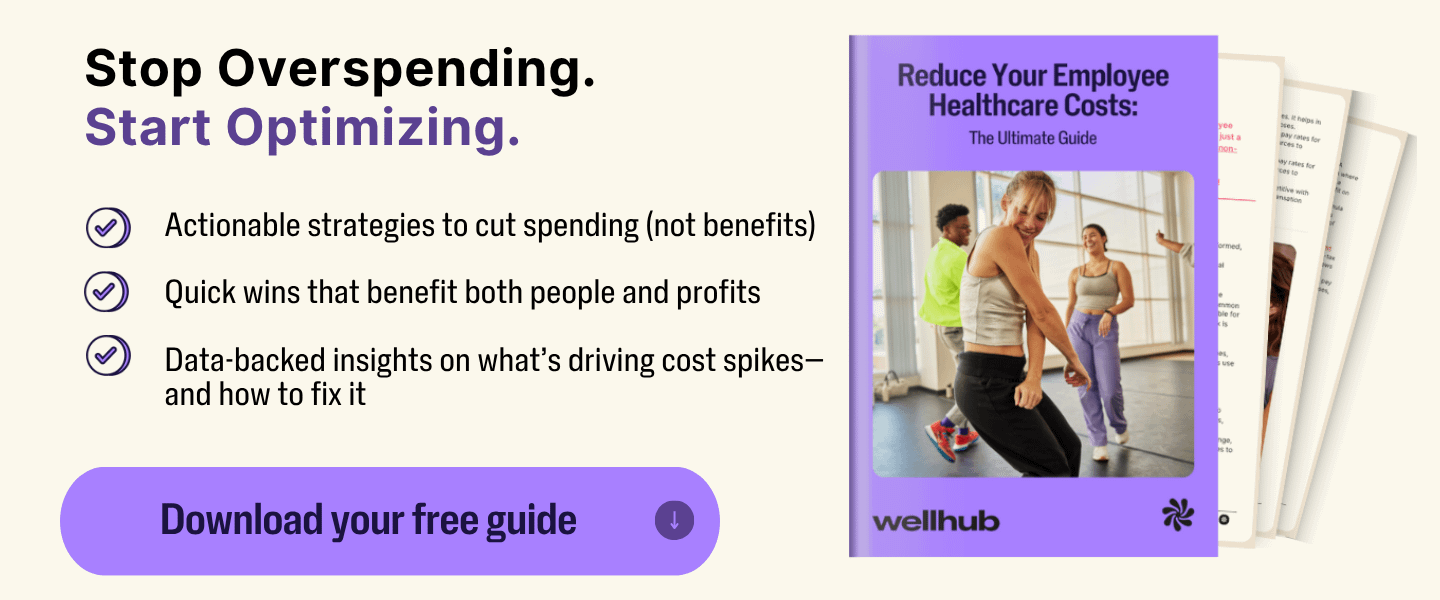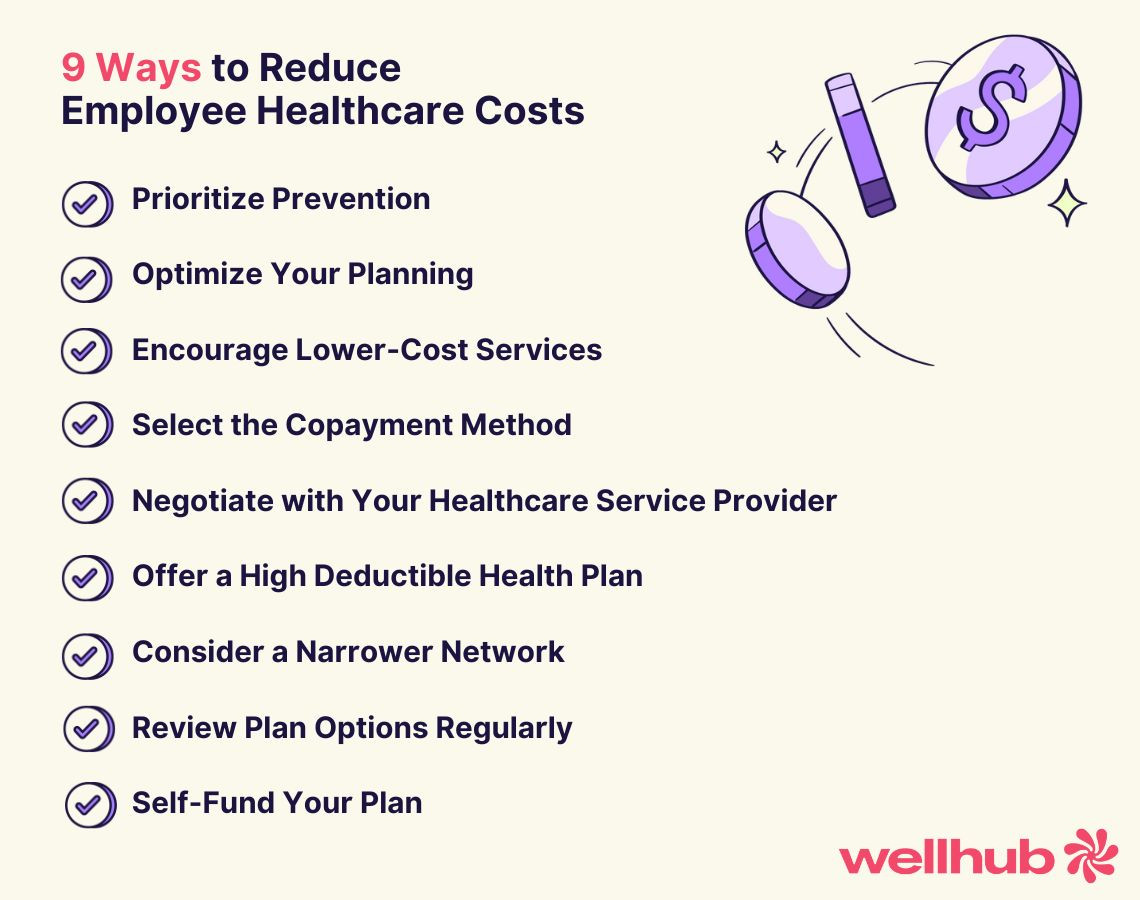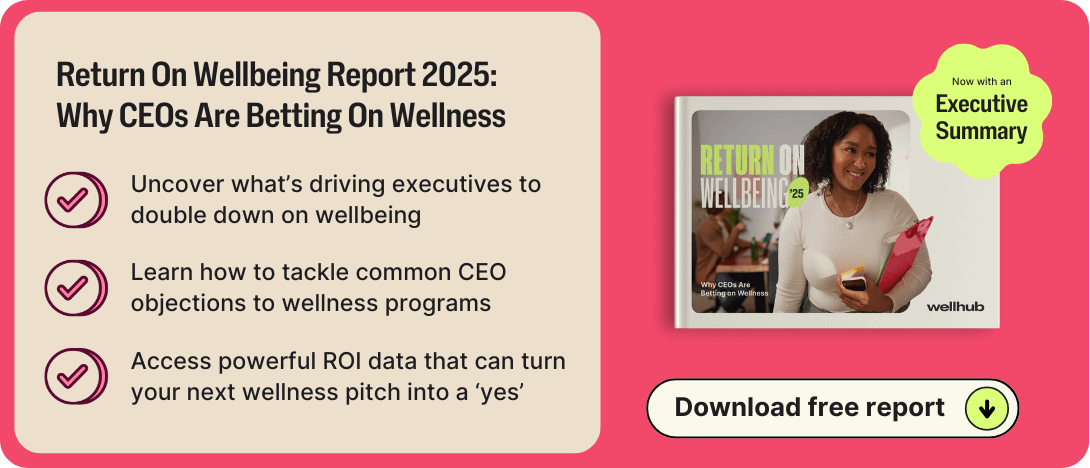How to Reduce Healthcare Cost: 9 Tips for Employers
Last Updated Jul 3, 2025

Last fall, Sarah at Thrive Corp. opened her renewal notice and felt her stomach drop. Premiums had jumped again—this time by 7%.
Her CFO wanted cuts. Her employees wanted better coverage. And she was caught right in the middle, trying to stretch a shrinking budget without sacrificing care.
She’s not alone.
Healthcare costs are exploding. A single employee plan now averages nearly $9,000 a year. Family coverage surged past $25,500 last year. And the trend isn’t slowing down—group insurance costs are expected to rise another 8% this year. All in a country that already spends nearly twice as much per person on healthcare as other developed nations.
The pressure is real. But there’s still room to act.
Uncover the strategies smart HR leaders are using to manage rising costs without compromising employee wellbeing. These 9 tactics can help you stay ahead before your next renewal hits.
What You'll Learn
- Prevention-First Strategies Lower Long-Term Costs: Investing in holistic wellbeing programs that address physical activity, mental health, sleep, and nutrition helps prevent chronic conditions—reducing healthcare claims and increasing productivity.
- Smart Plan Design and Planning Boost Efficiency: Aligning benefits with employee needs through data-backed planning, regular reviews, and communication improves utilization and eliminates wasteful spending.
- Low-Cost Care Options Deliver High Value: Encouraging use of telehealth, HSAs, and narrower networks helps employees access quality care affordably while significantly reducing employer costs.
- Cost-Sharing and Negotiation Can Stretch Budgets: Tools like copayments, HDHPs, and insurer negotiation provide cost-sharing solutions that balance employee satisfaction with financial sustainability.
- Wellness Programs Drive Real ROI: Employers with effective wellbeing programs report up to 35% reductions in healthcare costs and higher retention, engagement, and performance—proving wellness is a powerful lever in benefits cost control.

Healthcare Cost Reduction Strategies
Strategy 1: Prioritize Prevention
An ounce of prevention is worth a pound of cure — and prevention costs a whole lot less, making it a major boon for employers looking to reduce healthcare costs.
Many health insurance plans include full coverage for yearly physicals and similar non-treatment services. That’s a great start on preventative treatment! But having a doctor go through your vitals every 12 months isn’t a comprehensive approach to maintaining good health. Instead, the most effective employer healthcare packages include workplace health and wellness programs. Employee wellbeing programs reduce healthcare costs by supporting the ongoing health of employees so they do not need to make a claim. And many of these programs can be run at low or no cost to employers when they utilize wellness dollars, which are funds healthcare insurers set aside to help companies pay for qualifying wellbeing programs.
These initiatives can improve employee health in a variety of ways, including improving activity levels, mental wellbeing, sleep, and nutrition.
💡 Pro Tip: Check with your insurance carrier about available wellness dollars or incentive programs—they often go unused and can fully fund preventative initiatives like fitness classes or mental health apps.
Physical Activity
Wellness programs can increase activity levels, which helps to significantly reduce the incidence (and the associated treatment costs) of disease. The costs of inactivity are staggering: the global cost of treating new cases of preventable non-communicable diseases will reach US$ 300 billion by 2030, according to the World Health Organization.
There are many programs employers can offer that help employees get up and move, from personal trainers to digital exercise courses. And gym subscriptions allow for customized physical activity plans in a fast and customizable manner, in line with the available budget.
💡 Pro Tip: Offer flexible options—like step challenges, digital fitness memberships, or lunch-break yoga—to engage remote, hybrid, and in-office employees equally.
Learn More: How To Lower Corporate Healthcare Costs By Boosting The Physical Activity Of Employees
Mental Wellness
Emotional support can play a major role in creating a healthy workplace. Mental health conditions — from depression to anxiety to Alzheimer's — are costly and make it difficult for employees to work effectively. Spending on mental health conditions increased by 50% during the pandemic, and spending remains 39% above pre–pandemic levels. Wellbeing programs can help employees manage their emotional health with tools like yoga classes and meditation apps.
💡 Pro Tip: Launch a quarterly mental wellbeing check-in with pulse surveys or anonymous feedback tools to gauge what support employees actually want—and adjust programs accordingly.
Learn More: How Mental Wellbeing Programs Reduce Corporate Healthcare Costs
Sleep
Good health starts with a good night’s sleep. Even one night of poor sleep can be problematic, destabilizing mood and increasing the chance of causing an accident on the road or in the workplace. Insufficient sleep over time is linked to a wide variety of major health issues, from depression to obesity. Offering a wellbeing program that incorporates tools like meditation and sleep trackers can help employees get the Zs they need to protect their health.
💡 Pro Tip: Share evidence-based sleep resources in benefits communications and consider bundling sleep support into your existing EAP or wellbeing platform.
Learn More: How to Reduce Corporate Healthcare Costs By Helping Employees Get Better Sleep
Nutrition
A healthy diet is foundational to a healthy life. Clean eating can help elongate people’s healthspan and lifespan. On the other hand, a poor quality diet over time can cause a host of costly health conditions, including obesity, type 2 diabetes, and heart disease. Wellness programs can help employees form and maintain healthy eating habits through services like nutritionists and nutrition tracking apps.
💡 Pro Tip: Partner with a registered dietitian for a live Q&A or webinar, then follow up with access to a nutrition tracking app employees can use all year.
Learn More: How Improving Employee Nutrition Can Lower Corporate Healthcare Costs
A holistic wellbeing program can drive a notable decrease in healthcare spending. In one study of more than 17,000 employees with access to Wellhub’ wellness platform, healthcare spending for frequent users dropped by as much as 35% in just one year. As a holistic program, Wellhub provides members with access to thousands of wellness resources. These support emotional and physical wellbeing, from sleep apps and nutrition trackers to guided meditations and fitness classes. This well-rounded approach to wellness helps improve overall health, driving down the need for expensive healthcare interventions.
Strategy 2: Optimize Your Approach to Planning
Anyone who’s ever tried to submit an insurance claim knows healthcare is a complex affair. A 2020 survey of healthcare consumers found that not a single aspect of managing their own healthcare is considered ‘effortless,’ and over half (53%) of survey respondents have avoided seeking care due to the perceived difficulty in finding, accessing, and paying for it.
When handling one claim is a headache, orchestrating an entire workforce’s worth of health insurance can get convoluted quickly.
This is why effective (and cost-effective) employee healthcare starts with effective management and planning. First and foremost, you will need to define two essential areas: Your objectives and your budget. These factors will help establish the parameters of your healthcare solutions, giving you an overview of employee and employer needs. This lets you know when you’ve found something that fits both sets of requirements.
Next, conduct a needs assessment to determine the form your benefits should take and what specific benefits you should include. If you already have an existing benefits plan, part of the needs assessment is a review to see which benefits your employees are actually using and which ones aren’t being touched.
Bring all of this information together to design and roll out the benefits package. Be sure to communicate the benefits to your employees in clear terms so they fully understand what’s covered in their policies and feel confident enough to use them. Periodically review and evaluate your program against the organizations’ and employees’ needs, and make any changes where necessary.
Taking a deliberate and data-backed approach to healthcare planning can help your business dial in on the benefits that matter most without paying for features that go unused.
💡 Pro Tip: Build a cross-functional benefits committee (HR, finance, and a few employee reps) to align objectives and surface practical insights before rolling out plan changes.

Strategy 3: Encourage Lower-Cost Services
Lower cost doesn’t mean less effective. Take, for example, telehealth care. Telehealth, virtual therapy, and other lower-cost services are convenient, encouraging employees to use them more often and take a more active role in maintaining their health. They’re also less costly to employers.
The COVID-19 pandemic and the resulting lockdown order made it difficult and dangerous for patients to visit their healthcare providers in person. In response, many providers began offering telehealth services — allowing patients to meet with doctors and other health professionals remotely via online conferencing. Several years later, telehealth remains a staple of many healthcare plans. It provides on-demand care at a fraction of the cost of traditional in-person visits; remote consultations cost around $50, while an in-person visit can cost more than $170.
Connecting employees with access to this kind of affordable services often leads to an increased likelihood of them opting for high-deductible plans that include a health savings account (HSA) that come with lower costs. This, in turn, results in reduced premiums for fully insured employers and decreased claims expenses for self-insured and level-funded employers. That’s what a win-win situation looks like in healthcare.
💡 Pro Tip: Create a “Know Where to Go” guide that outlines when to use telehealth, urgent care, or ER. Distribute it during onboarding and open enrollment.
Strategy 4: Choose the Copayment Method
You can also consider spreading costs by using copays. Copayments make it possible for employers and employees to share in the responsibility of paying for doctor visits, tests, procedures, and other medically-relevant expenses. These payments are made at the time the service is provided and are usually relatively affordable — the average cost of a copayment is $25 for a standard doctor’s visit and $42 for a specialty visit.
By cost sharing in this area, employers can negotiate lower premiums with their insurance providers. Often, these copays can even be put towards annual deductibles.
That said, you need to be careful when shifting too much of the cost to the people who are supposed to be benefitting. Copayments are widely used and generally accepted by employees as a natural part of employer-sponsored healthcare benefits, but pushing too much of the costs to your employees could decrease employee satisfaction. It may even impact your employee retention if competing companies offer a more lucrative benefits package. On the other hand, when used appropriately, copayments make it possible to maintain healthcare coverage and quality without increasing expenditures.
💡 Pro Tip: Run a total compensation statement for employees showing their full benefits package—including your contribution—to frame copays as part of a valuable overall offer.
Strategy 5: Negotiate with Your Healthcare Service Provider
Although your Healthcare Service Provider may quote you prices, it’s good to remember that insurance solutions are negotiable. After all, insurance companies want to turn a profit, and they can’t do that unless they can act competitively when bringing in new policies. They want your business. They need your business. And in many cases, they’ll fight for your business at the negotiating table.
The more employees you have, the more bargaining power you might have during negotiations. Providers may be more willing to offer competitive rates and benefits if they know they can gain a significant number of customers.
You can focus on the best value over simply the cheapest option. Make sure to evaluate the overall quality of care provided, access to specialists and hospitals, and additional services offered. Consider negotiating for flexibility in plan design, allowing you to tailor healthcare benefits to meet the specific needs of your workforce. Remember to ensure that any negotiated contract aligns with legal and regulatory requirements to avoid potential issues in the future.
If both you and your provider are serious about finding common ground, it should be possible to agree on terms that will maintain the quality of the service without harming the parties involved (employee or employer). And if the provider does not want to negotiate, then consider returning to the market to see if other, more-amiable options are available.
💡 Pro Tip: Run a total compensation statement for employees showing their full benefits package—including your contribution—to frame copays as part of a valuable overall offer.

Strategy 6: Offer a High Deductible Health Plan (HDHP)
A healthcare plan with a higher deductible might sound counterintuitive — but for many companies, it’s a smart financial choice. High Deductible Health Plans (HDHPs), especially when paired with Health Savings Accounts (HSAs), can significantly lower monthly premiums. That’s good news for both your business and your employees.
An HSA helps employees set aside pre-tax dollars to pay for eligible healthcare expenses, which can reduce their financial burden when medical needs do arise. And since these funds roll over year to year and stay with the employee even if they leave the company, it’s a benefit that boosts both short-term savings and long-term satisfaction.
When employees are empowered to manage their own healthcare spending, they’re more likely to shop around for cost-effective services — which, in turn, can reduce overall claims and healthcare costs for your business.
💡Pro Tip: Offer an employer-funded HSA contribution—especially early in the plan year. It boosts adoption, eases the deductible burden, and shows employees you're invested in their financial wellbeing.
Strategy 7: Consider a Narrower Network
Sometimes, less is more. Choosing a health plan with a narrower provider network — a more limited selection of doctors and hospitals — can reduce your healthcare premiums without sacrificing quality. Narrow networks typically focus on high-performing providers who offer quality care at lower costs.
By working with carriers that emphasize quality over quantity, you can keep spending in check and help your employees access efficient care. It’s a strategy that maximizes value, especially for employers managing large or growing teams.
Want to ensure your team is still getting the care they need? Look for plans that offer strong patient satisfaction scores, access to top specialists, and telehealth integration.
💡 Pro Tip: Request provider quality and utilization data from your carrier before selecting a narrow network. Focus on plans that include high-performing providers with strong patient satisfaction and low readmission rates.

Strategy 8: Review Your Plan Options Regularly
If you haven’t checked your healthcare plans lately, you might be leaving money on the table.
Healthcare is shifting. So should your strategy. (Just think about GLP-1s!) Reviewing your plan offerings each year — including deductibles, copays, and covered services — can uncover valuable opportunities to save. Maybe it’s time to renegotiate with your provider. Maybe your employees would benefit from a different coverage mix. Or maybe your population health data suggests a shift in plan design could deliver better outcomes for less.
A regular review ensures your benefits are still aligned with your people and your business goals. This step also gives you the chance to educate employees on how to use their benefits most effectively — helping reduce unnecessary ER visits or out-of-network charges.
💡 Pro Tip: Schedule a mid-year plan audit, not just an annual review. It gives you time to adjust strategy before open enrollment and strengthens your position when negotiating with brokers and carriers.
Strategy 9: Self-Fund Your Plan
If you're ready to take greater control over your healthcare spending, self-funding might be worth a look.
Unlike fully insured plans, where insurers take on the risk, self-funded plans allow employers to pay for claims directly. That means if your employee population is generally healthy, you only pay for what gets used — not for a preset premium based on projected usage.
Self-funding can feel like a leap, especially for small- and mid-sized employers. But with the right third-party administrator and stop-loss coverage to protect against high-cost claims, it’s a viable option that offers transparency and potential savings.
You’ll gain access to your claims data, which can help you make smarter decisions about plan design and preventative care initiatives. It’s a powerful way to match your benefits strategy to your workforce’s actual needs.
💡Pro Tip: Start with a level-funded plan if you’re new to self-funding. It offers fixed monthly payments with year-end rebates and gives you access to claims data without full exposure to risk.
Cut Your Healthcare Costs by a More Than a Third
Workforce wellness is a primary determinant of a company’s healthcare costs. Supporting the health of your staff with an employee wellbeing program can directly impact your healthcare spending — three out of four of HR leaders report their wellness program reduces the cost of providing healthcare benefits.
In a study of more than 19,000 employees, Wellhub clients saw their healthcare costs reduce by up to 35%. These are significant savings, especially as the cost of providing healthcare to employees in the U.S. is anticipated to rise more than 6% year over year.
Speak with a Wellbeing Specialist today to discuss how we can help you reduce your healthcare costs.

Company healthcare costs drop by up to 35% with Wellhub*
See how we can help you reduce your healthcare spending.
[*] Based on proprietary research comparing healthcare costs of active Wellhub users to non-users.
References
- Rubin, A. (2023, August 28). Americans invested in their mental health during the pandemic. Axios. https://www.axios.com/2023/08/28/mental-health-spending-pandemic
- Davalon. (October 13, 2022). Understanding a Health Insurance Copayment. eHealth. https://www.ehealthinsurance.com/resources/small-business/understanding-health-insurance-copayment.
- Kaiser Family Foundation (2021, November 10). 2021 Employer Health Benefits Survey. KFF.org. https://www.kff.org/mental-health/report/2021-employer-health-benefits-survey/
- KFF. (2023, October 18). 2023 Employer Health Benefits Survey. Retrieved November 13, 2023 from https://www.kff.org/report-section/ehbs-2023-summary-of-findings/
- Lagasse, Jeff. (December 14, 2022). Health Benefit Costs Expected to Rise 5.4% in 2023. Healthcare Finance News. https://www.healthcarefinancenews.com/news/health-benefits-costs-expected-rise-54-2023.
- Leo, L., & Mandowara, K. (2023, September 21). US employers to see biggest healthcare cost jump in a decade in 2024. Reuters. https://www.reuters.com/world/us/us-employers-see-biggest-healthcare-cost-jump-decade-2024-2023-09-20/
- Lagasse, Jeff. (July 13, 2020). Half of Consumers Avoid Seeking Care Because It's Too Difficult. Healthcare Finance News. https://www.healthcarefinancenews.com/news/half-consumers-avoid-seeking-care-because-its-too-difficult.
- WHO Highlights High Cost of Physical Inactivity in First-Ever Global Report. (October 19, 2022). World Health Organization. https://www.who.int/news/item/19-10-2022-who-highlights-high-cost-of-physical-inactivity-in-first-ever-global-report.
- Why are Americans paying more for healthcare?. Peter G. Peterson Foundation. (2023, July 14). https://www.pgpf.org/blog/2023/07/why-are-americans-paying-more-for-healthcare
Category
Share

The Wellhub Editorial Team empowers HR leaders to support worker wellbeing. Our original research, trend analyses, and helpful how-tos provide the tools they need to improve workforce wellness in today's fast-shifting professional landscape.
Subscribe
Our weekly newsletter is your source of education and inspiration to help you create a corporate wellness program that actually matters.
By subscribing you agree Wellhub may use the information to contact you regarding relevant products and services. Questions? See our Privacy Policy.
Subscribe
Our weekly newsletter is your source of education and inspiration to help you create a corporate wellness program that actually matters.
By subscribing you agree Wellhub may use the information to contact you regarding relevant products and services. Questions? See our Privacy Policy.
You May Also Like

Cut Healthcare Costs with Smarter Wellness Programs | Wellhub
Cut claims, boost engagement, and rein in healthcare costs with a data-driven wellness strategy designed to work for your team and your budget.

Beyond the Basics: Variable vs. Fixed Costs | Wellhub
Master the art of cost classification and optimize business expenses. Explore variable vs. fixed costs and discover Wellhub solutions for financial fitness.

Cost Management: A Quick Guide to What It Is and Why It’s Important
Cost management isn’t just for finance teams. Here’s a guide to cost management for HR leaders and professionals.